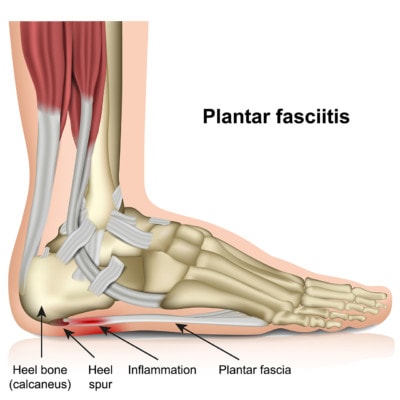Plantar Fasciitis Release Surgery is a Bad Idea
Have you ever had Plantar Fasciitis? It’s one of those truly painful things that every inflight airline catalogue has 5 different gadgets to fix. Well it turns out that any one of those gadgets would be better than Plantar Fasciitis Release Surgery, according to the results of a recent study.

Medicalstocks/Shutterstock
Plantar fasciitis is a problem involving the tough supporting structure on the bottom of the foot, the Plantar Fascia, which is a band of tissue that goes from the base of the toe and attaching at the bottom of the heel. When this area is overloaded, develops micro-tears, or when associated nerves in the back are irritated, it can become painful to walk. One of the hallmarks of Plantar Fasciitis is the sharp pain which is at it’s worst with the first few steps in the morning. Conservative treatment involves physical therapy, rest and ice, stretching the calf muscles and supporting the arch with various braces, orthotics and contraptions.
This study looked at the long term effectiveness of a different course of action, Plantar Fascia Release Surgery. The study was actually set up because a group of doctors from 3 different hospitals in the UK had noticed that they hadn’t seen the supposed 80% success rate for this surgery in their own patients. They studied 24 patients, ages 24-61, more women than men who had tried conservative treatment for an average of 3 years prior to surgery, and followed them for an average of 6 1/2 years after surgery. Their conclusions were twofold; receiving steroid injections prior to surgery had a very negative effect on the outcome, and, given the prolonged and difficult recovery and the generally poor outcomes of plantar fasciitis release surgery it has questionable value, as most patients would have improved over this time period without the surgery. Not exactly a vote of confidence…
The upshot? No surprises there! We know steroid injections kill the local stem cells which make it impossible for them to repair the damage. We also know that cutting into an already damaged ligament which hasn’t been able to heal on its own and permanently changing the biomechanics of the foot, doesn’t end well. If conservative treatment doesn’t work, additional studies and certainly our results have shown that PRP can help the problem without the issues of either steroid shots, or surgery. Make sure you start with a good exam, as heel pain can also be caused or made worse by an irritated S1 nerve in the low back. But in the end, whether your plantar fasciitis resolves with conservative treatment or requires PRP to accomplish healing, either treatment is a better deal no matter how you look at it!

If you have questions or comments about this blog post, please email us at [email protected]
NOTE: This blog post provides general information to help the reader better understand regenerative medicine, musculoskeletal health, and related subjects. All content provided in this blog, website, or any linked materials, including text, graphics, images, patient profiles, outcomes, and information, are not intended and should not be considered or used as a substitute for medical advice, diagnosis, or treatment. Please always consult with a professional and certified healthcare provider to discuss if a treatment is right for you.
